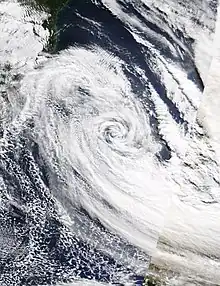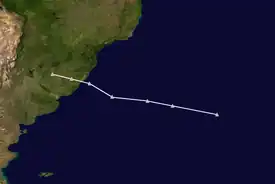 Satellite image of the system impacting Brazil on July 1, 2020 | |
| Meteorological history | |
|---|---|
| Duration | 30 June 2020–3 July 2020 |
| Extratropical cyclone | |
| Highest winds | 140 km/h (85 mph) |
| Overall effects | |
| Fatalities | 12 fatalities[1][2] |
| Areas affected | Rio Grande do Sul, Santa Catarina, Paraná, São Paulo, Rio de Janeiro |
| Power outages | >1.9 million[1][2][3] |
The June 2020 bomb cyclone was a hurricane-force extratropical cyclone in South Region, Brazil which impacted the states of Santa Catarina, Rio Grande do Sul and Paraná on June 30, 2020. Twelve deaths were confirmed, ten in Santa Catarina, one in Rio Grande do Sul and one in Paraná. In addition to almost 1.9 million consumers without electricity in the three states.[1]
Meteorological history and impact

Tropical storm (39–73 mph, 63–118 km/h)
Category 1 (74–95 mph, 119–153 km/h)
Category 2 (96–110 mph, 154–177 km/h)
Category 3 (111–129 mph, 178–208 km/h)
Category 4 (130–156 mph, 209–251 km/h)
Category 5 (≥157 mph, ≥252 km/h)
Unknown

During strong storms that hit the South Region of Brazil on June 30, 2020, cities registered winds of more than 120 km/h in several points of Santa Catarina, Rio Grande do Sul and Paraná. This phenomenon is known as bomb cyclone, because in this region a sharp drop in atmospheric pressure was recorded over a period of 24 hours, causing cyclones that were not predictable by meteorologists.[4]

Until 9pm BRT on the 30th, three deaths were registered as a result of cyclones in Santa Catarina, one in the city of Chapecó, one in Santo Amaro da Imperatriz and one in Tijucas, besides one death in Rio Grande do Sul, in the city of Nova Prata.[1][2]
References
- 1 2 3 4 "Ciclone bomba: sobe para 10 o número de mortes no Sul do país; 686,6 mil imóveis estão sem energia em SC" [Cyclone bomb: death toll rises to 10 in the South; 686,600 properties are without power in SC]. G1 (in Brazilian Portuguese). July 1, 2020. Retrieved July 1, 2020.
- 1 2 3 "Chuva, granizo e vento forte provocam uma morte e estragos em várias cidades do RS" [Rain, hail and strong wind cause death and damage in several cities of RS]. GaúchaZH (in Brazilian Portuguese). 2020-06-30. Retrieved 2020-07-01.
- ↑ "Ventos de quase 100 km/h derrubam árvores e deixam 193 mil imóveis sem energia, em Curitiba" [Winds of almost 100 km/h cut down trees and leave 193 thousand properties without energy, in Curitiba]. G1 (in Brazilian Portuguese). Retrieved 2020-07-01.
- ↑ "Existe ciclone bomba?" [Do cyclone bombs exist?]. Terra (in Brazilian Portuguese). 2020-06-30. Retrieved 2020-07-01.